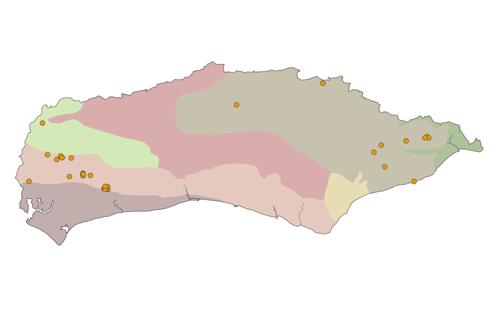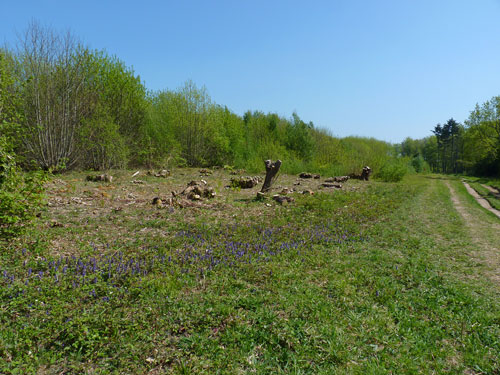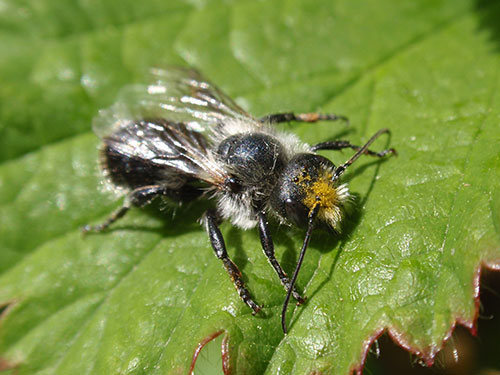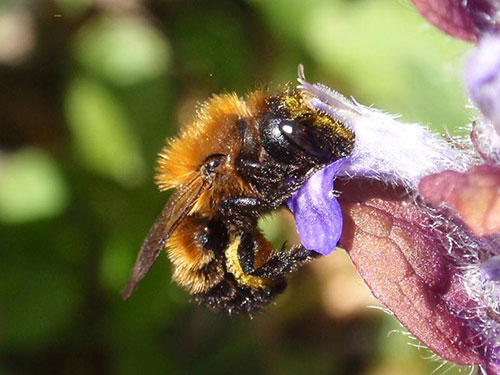


Map showing the locations of the few records of Osmia pilicornis that are in the SxBRC database

Potential Osmia pilicornis habitat - a rotationally coppiced scallop with an abundance of Bugle in the foreground
Photo: Neil Hulme

Male Osmia pilicornis
Photo: Rosie Bleet

Female Osmia pilicornis on Ajuga reptans
Photo: Rosie Bleet
May is the peak of the flight-season for Pearl-bordered Fritillary Boloria euphrosyne, one of Sussex’s rarest butterflies (see: Species of the Month, May 2019). In Sussex, this butterfly inhabits a small number of actively managed coppiced ancient woodlands and this is one of the habitats in which Fringe-horned Mason Bee Osmia pilicornis may also be found, it is also known to use areas of newly clearfelled woodland. Because of its requirement for these early successional woodland habitats, O. pilicornis is, like the Pearl-bordered Fritillary, a declining and threatened species.
Rare in Sussex, O. pilicornis has only been recorded 50 times in the two counties and only nine times this century, the most recent record being from 2017.
Osmia pilicornis adults fly in a single brood from April through to the end of June and can be found visiting a number of springtime woodland flowers such as Ground-ivy Glechoma hederacea and violets Viola spp. but most frequently it is to be seen on Bugle Ajuga reptans. The bee makes its nest in existing holes in fallen or standing deadwood such as coppice stools, fallen branches or tree-stumps. The females construct cells within the burrows from chewed-up pieces of leaf. Once constructed, the cell is provisioned with nectar and pollen and a single egg is laid. When the larva hatches it consumes these supplies and overwinters as an adult within the cell.
The adult bee is about 8mm long and the females are characterised by the thick reddish hairs on the back of their thorax and the first part of the abdomen, underneath and on the face the hairs are black. A key distinction is the presence of hooked black bristles on their moth parts which are used for collecting pollen from the anthers of the tubular flowers that they visit. The males are less distinctive than the females and are paler greyish or silvery in colour but can be distinguished from the similar males of the closely related Red-tailed Mason Bee O. bicolor by the long hairs on the trailing edge of the antennae. There are 13 Osmia species in the UK, eight of which have been recorded in Sussex and despite the subtlety of the characteristics that distinguish this species from other Osmia species it is possible to identify it in the field using a good hand-lens.
There has been a significant amount of work undertaken in Sussex in recent years to restore habitats suitable for Pearl-bordered Fritillary and so it would be very welcome to find that this bee is benefitting from this work too. Please send the details of any sightings either directly to bobforeman@sussexwt.org.uk at the SxBRC or enter them on iRecord.
References
BWARS website
Falk, S. 2015. Field Guide to the Bees of Great Britain and Ireland. Bloomsbury
Every month it is our aim to highlight a species that is “in-season” and, although not necessarily rare or difficult to identify, has been highlighted by our local recording groups as being somewhat under-recorded and for which new records would therefore be welcomed.
If you or your recording group are aware of species such as this then please contact Bob Foreman.